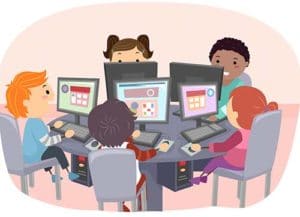We are living in a time where we are experiencing rapid technological changes, and it can be a challenge to integrate these new technologies into a classroom setting. Computer technology is becoming more important in the classroom as a tool to stimulate good teaching and learning practices. Computers, the internet, and other technologies and platforms are making educational resources available worldwide, allowing for a greater spread of knowledge and information than ever before. Bringing them together effectively in the classroom is what we call “blended learning”. Blended learning is the practice of combining traditional learning methods with the use of technology in order to redefine what is possible in education. It has become a huge topic of discussion for teachers around the world, so below we’ve listed some tips and tricks on how you can not only handle technology, but harness it to the greatest effect in your classroom.

Classroom Set Up
How you physically set up the space can be really important when preparing a classroom to use technology. There are a few models you could use depending on the activity/project you have planned for the course. Usually, you want to set up the class so you can see all the students’ screens. This is a great preventative measure to keep students on task, as technology can be extremely distracting if used incorrectly. Having a view of all the students’ screens also helps you monitor the student progression through their task or assignment. You can easily spot a student who is lost or is having trouble working the program, and then give them the extra support they need. One good way to have a view of every student’s screen is by moving your desk to the back of the class if all the kids are normally facing forward. This prevents you needing to move all their desks around, and can be an easy, temporary change. Another option is to create a circle around the class. If the desks face the wall, place yourself in the middle to give yourself an easy view of all the children’s devices. If desks face the centre, make sure you have room to walk around the perimeter of the circle to monitor all the devices.
Student Log In System
One of the most common headaches that come from using technology in the classroom is keeping track of students passwords and usernames. Kids are constantly forgetting them or having difficulties inputting the correct password, but there are some quick and easy ways to deal with this. If you have older students, you can help your kids become more independent by creating login cards to keep track of passwords and usernames for relevant sites. Putting all passwords on one card creates an easy tool that kids can keep with them and reference when needed. If your students are too young to keep their own passwords, having an easily accessible file with all passwords available is a great tool to have. Another great tool to use in the classroom is Clever. Celever is a great program that stores all your student’s passwords and inputs them automatically into your favourite programs.
Teach Mini-Lessons Before Giving Out Devices
Kids get distracted easily and it can be hard to hold their attention when there is something exciting in front of them. Trying to explain lessons or assignments while kids are firing up devices or trying to put in passwords is extremely difficult. You might get asked to repeat instructions 10 times over! You can avoid this by going over the lesson or assignment details before giving out devices to the kids. This will keep their attention on you and hopefully prevent any miscommunications or need for more explanation (at least most of the time ?).
Conduct Teacher Check-Ins
Technology is great for stimulating independent learning as it gives students the tools to answer their own questions and take control of their education. However, along with independence, it’s important to always have teacher check-in periods to see what progress students have made and answer any questions they may have. You could schedule a time once a week to meet with students, or send out a poll on Google Classroom asking students about their progress and requesting feedback.

Schedule Breaks From Devices
Although technology is an amazing resource for classrooms, student minds can begin to wander after too much time on a device. Being involved with a screen also limits the amount of face-to-face interactions students have. Give them a break away from technology to let them engage with classmates face-to-face, and give them time to refocus on the task at hand. One great way to do this is by incorporating technology into stations. Revolve students around the classroom with some technology related stations and some group work stations. Give the kids a set period of time at a station then everyone shifts to the next one.